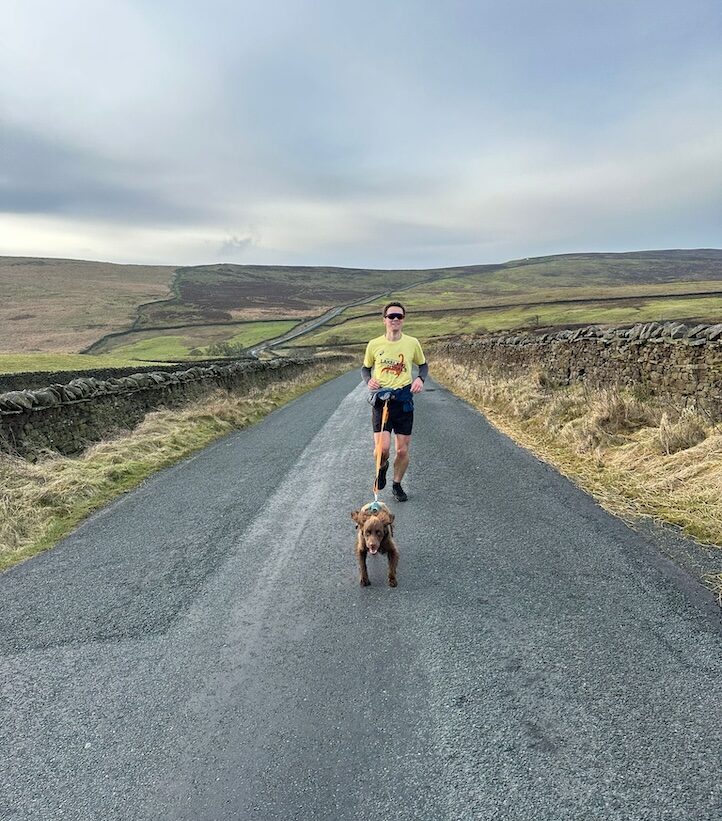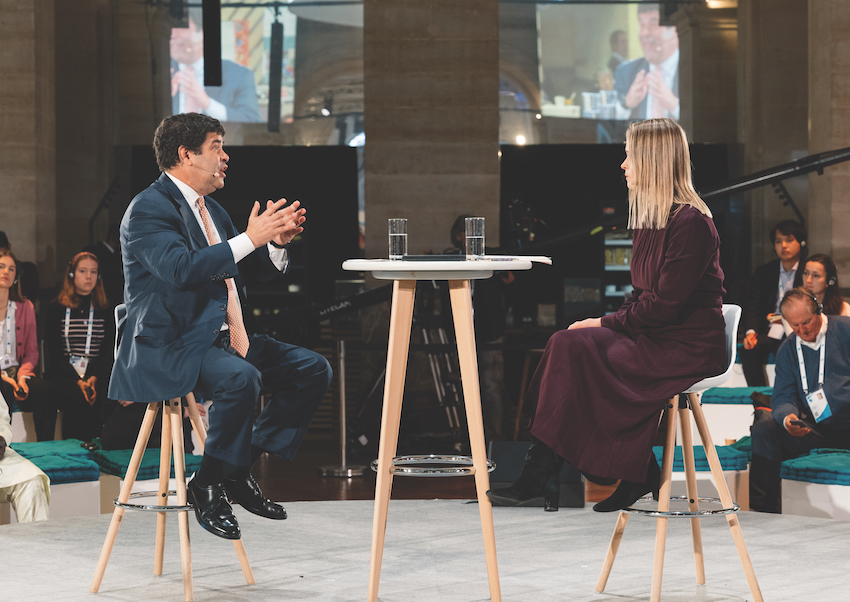At the London Marathon, Jono Astle is trying to set a world record he would have never chosen. By Edward Stephens.
To live with multiple sclerosis is to inhabit a body at war with itself. The immune system that normally protects our health instead corrodes it by mistakenly attacking the body’s nervous system. Over time, the damage disrupts the signals racing between the brain and the body. You want to lift your foot, or your hand, but the signal from the brain gets to those nerves slowly, or not at all. It is a viciously unpredictable, degenerative neurological disease—there is no telling when its symptoms will flare up, how long those flares will last, what might trigger them again, or how you will recover. There are different types of MS, yet two people with the same kind can have wildly different experiences of the disease. Research shows that depression rates among people living with MS are higher than those living with a terminal illness. We don’t know what causes MS. And we don’t know what cures it.
Jono Astle, a Director at Brunswick who celebrated his 30th birthday last year, has multiple sclerosis. And repeatedly in our conversations he uses the same word: lucky.
Lucky not because an MS diagnosis is a gift (it isn’t), or because the disease has delivered an epiphany (it hasn’t), nor any treacly takeaway that MS might appear to offer when you don’t have to endure its random sufferings.
No, Jono says he is lucky because he has been diagnosed with MS at a time when the treatment for it has never been better and he can access that treatment; he is lucky because a cure within his lifetime—if not his career—seems plausible; he is lucky because there are men and women with MS who cannot walk or control their bladder, while all of his scans have shown no sign of the disease progressing; he is lucky because his wife, parents, siblings, friends, colleagues (and cocker spaniel) are in his corner. He is lucky because he can still run.
It will not be luck, however, that sees Jono toe the starting line of the TCS London Marathon on April 21st. Nor will it be luck if he crosses the finishing line having achieved his goal of setting a Guinness World Record (GWR) for the fastest marathon with MS.
On its website, GWR lists no current holder of that record. For new record attempts, meanwhile, GWR says it “will set a challenging minimum requirement for you to beat.” Jono says GWR set him a requirement of 3 hours and 30 minutes—a time he’s hoping to beat handily. His dream is to finish in under three hours. For that, he would need to average 6 minutes and 50 seconds per mile, or 4 minutes and 15 seconds per kilometer, for 26.2 miles. Only 6% of finishers at the 2023 London Marathon achieved that feat. “What’s the point of just trying to set something?” Jono says. “Might as well smash it.”
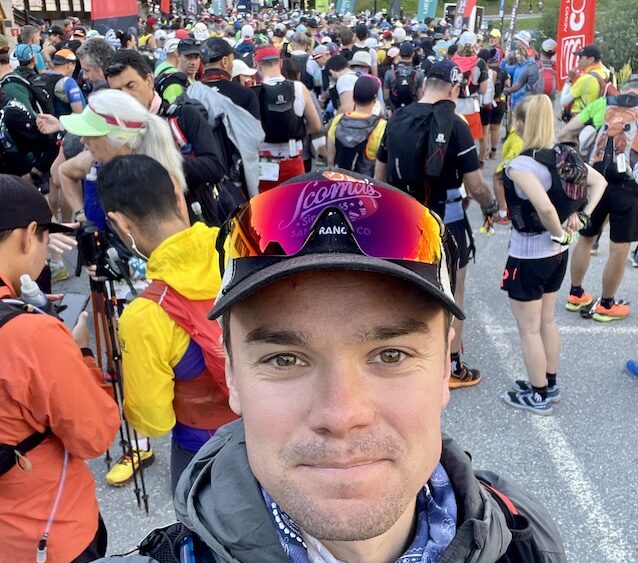
Home away from home—Jono at a starting line.
Jono’s attempt is, of course, made even more challenging by the complications of training with MS. Every hiccup along the way, every tingling sensation, every low-energy day “puts in the back of your mind: ‘oh no, maybe this is the start of something bigger,’” Jono says.
Every six months, Jono has an infusion that essentially wipes out half of his white blood cells. The concoction decimating his immune system includes a potent steroid that “makes you chat total crap,” Jono reports. “After my first dose I called my eldest sister and rattled off five new business ideas.” Lower white blood cells help treat the symptoms of MS, but leave Jono more prone to bugs and bacteria he might otherwise fight off. As his white blood cell count increases, so can his MS symptoms. When the London marathon starts, it will have been four months since Jono’s last infusion.
He will be paced on his attempt by two runners. One is Musa Adamu, the Facilities Manager for Brunswick in London, who is such a seasoned runner he now has to estimate how many races he’s run (“maybe forty marathons?” he says, and about half that number of ultra-marathons).
Jono’s other pacer is Ruth Astle, his older sister and a 3x Ironman triathlon champion (an Ironman triathlon is a 2.4 mile swim, 112-mile bike ride, and a marathon, raced in that order without any breaks). At Ironman Israel in 2022, one of Ruth’s victories, she ran a sub 3-hour marathon after swimming hard for an hour and then averaging 24.5 miles per hour (39.5 kph) on a bike for four and a half hours. A sign of just how much Jono’s attempt means to Musa and Ruth: neither would be running the race were it not for Jono.
Why a marathon?
There is something wonderfully defiant about running—running far, and running fast—with a disease that threatens to restrict your mobility. Combining that with a Guinness World Record attempt helps Jono raise money for the MS Society—so far he has raised more than £11,700 ($14,500). And it also helps him raise awareness about a disease that’s often called “invisible”—as in, you can look at someone and have no idea they have MS.
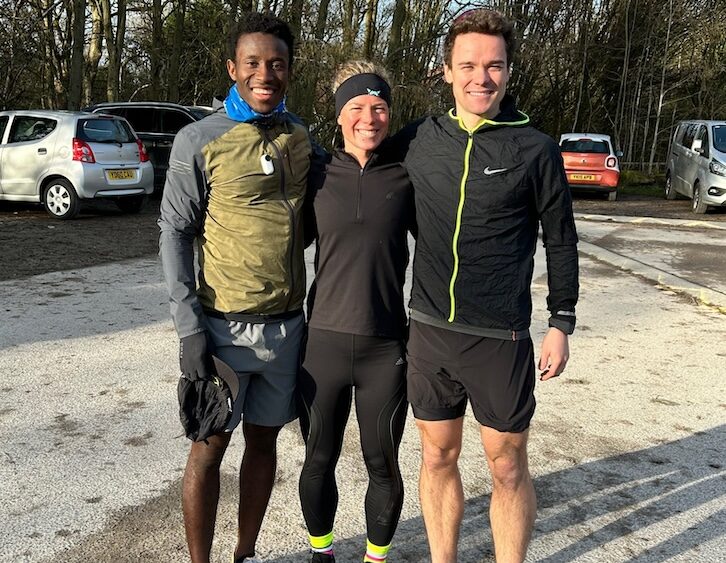
Jono with his pacers Musa Adamu and Ruth Astle (his sister) before a winter training run.
To support the MS Society through Jono, please visit his Just Giving page.
In his own way, Jono wants to help make MS more visible and also challenge people’s preconceptions and prejudices about it. “The story I think a lot of us grew up with is, if you have MS, it’s basically a wheelchair or, if you’re lucky, a cane,” says Jono. “Sadly, that’s still the case for some people. But I want to show that, thanks to how far modern treatments have come, that’s not the full story.” Jono shares his story on a fittingly titled website: The Invisible Runner.
In the early days of his diagnosis Jono was not chasing records and fundraising. He was angry, afraid, stunned. It all happened so quickly. He went temporarily blind in his right eye (optic neuritis, caused by an inflamed optic nerve, is a common symptom of MS). He rushed from work to the hospital. Then came the diagnosis. A particularly difficult moment, Jono recalls, came during one of his earliest infusions. Sitting next to him was a man roughly his age, yet much more debilitated by MS. Their heavy conversation left Jono despondent: Was that what awaited him?
While he was out from work, Jono received a call from Charlie Potter, a Brunswick Partner in London who had been diagnosed with MS in his late 20s. When interviewing to join Brunswick in 2012, Charlie had shared his diagnosis with the firm’s founders and had been moved by the fact that “for them, it simply wasn’t an issue at all.” But Charlie had initially been more selective in disclosing his illness at work. “I told colleagues with whom I worked most closely. But I certainly wasn’t open about it with clients at the beginning—you never know what private prejudices or misconceptions people might have, or how much they know about the condition,” Charlie says. “I didn’t want anyone to see me somehow as a lame duck, or not at the top of my game—for a client to think, ‘you know, I’d rather have someone who was in perfect health, actually.’”
He knew well that, in addition to the physical burden of MS, there is the ongoing issue of disclosure. As in: when you’re first diagnosed, who do you tell about the disease? And how, and when? Will people treat you differently? “It’s a very private form of disability if you have symptoms or interferences that aren’t easily noticeable,” says Charlie. “And disclosing isn’t a one-time gig. You tell a colleague or client about your diagnosis, the fact you’ve got the condition, but then how brave are you when you’re having an off-day, or when you’re concerned your symptoms are getting worse? How much do you share? But I’ve had reason to be more open about it with clients, colleagues and friends more recently, and been pleasantly reassured by how understanding and supportive they are.”

An important training partner will not be running with Jono on race day: Bosco, his three-year old working cocker-spaniel. “He’s a total joy,” says Jono, “there’s no judgment, ever. And rain or shine, he’s got to go out.” One of Bosco’s few shortcomings as a training partner, Jono says, is his preference for following squirrels rather than paths.
In those early conversations with Jono, Charlie says he simply tried to offer how he had navigated those many questions. And he also connected Jono with a doctor whose care had made a real difference. It was this doctor who first suggested that Jono, in fact, might consider himself lucky. “I remember looking at this guy and thinking, ‘what the f— do you mean?’” But the doctor’s clear-eyed reasoning and advice resonated. “He told me I could still go out and have a drink. That I could still work, run, travel—that the research suggested I could basically continue living my life. And that the understanding around MS, the treatments and prognosis for it, were better than they’ve ever been.”
Within two weeks of his diagnosis, Jono returned to work. “After all the appointments and uncertainty, it was actually quite nice to return to something familiar,” says Jono. He even started taking work calls during his infusions (camera off) because they “were a break from the oppressive monotony of six hours in a hospital.”
And so began a process that Jono describes “a shift from that initial fear, a reluctance to speak about it, to a kind of ‘I don’t give a damn’ about the disease, to now ‘how can I use it?’ … Time has been the biggest healer,” Jono says before stopping himself. “Actually, it hasn’t—that’s probably the worst phrase to use.”
In 2022, Jono participated in one of the world’s most difficult—and wonderfully named—ultramarathons, the Dragon’s Back. The course spans 236 miles (380 kilometers) and is raced over six days across “the mountainous spine of Wales.” In under a week racers climb almost 54,000 feet (think Mount Everest + Mont Blanc + Signal Mountain). “Participants underestimate it at their peril!” the race website enthusiastically warns.
Racing alongside Jono were Musa Adamu and Antony Dunkels, a Brunswick Partner who also has to guess the number of races he’s finished (including “maybe 50 or 60” ultramarathons). Antony found out about Jono’s MS diagnosis just before the race by reading Jono’s online race profile—MS, Jono wrote, was one of the reasons he was running.
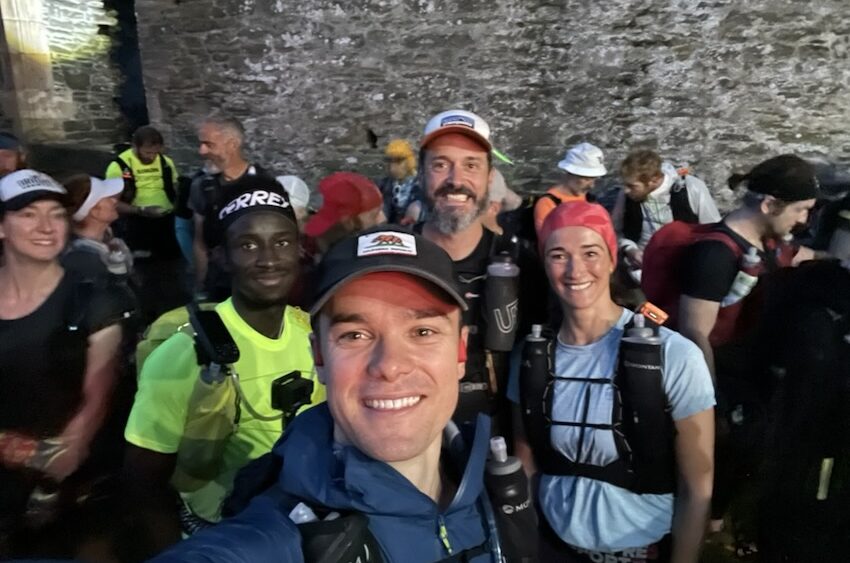
Before the start of the notorious Dragon’s Back ultramarathon: Jono with Musa Adamu, Antony Dunkels and Rebecca Ferry.
At the end of the third day, Jono had to withdraw from the race because he could not walk. “It’s such a shame his knees gave out because the guy is a frickin’ machine,” Antony says. “These races are really all about managing the pain; but sometimes you just can’t physically move forward.”
Days later Jono drove back from London to Cardiff to stand at the finish line he’d been unable to cross himself so he could cheer on Musa and Antony. “On the last day I was busted, I was fighting to just get to the end,” Antony says. “And he drove from London to Cardiff to meet me. And we ran maybe a mile or so together. And that just really … I only had five miles or so to go, but those are some of the longest miles … I was actually quite emotional. Him being there, when he had every reason not to be, tells you what kind of guy he is.”
The following year, Jono and nine Brunswick colleagues raced the Welsh 3000s, so named because it covers 15 separate peaks, each more than 3,000 feet high. In total, they climbed roughly the height of Mount Fuji and raised £5,400 ($6,800) for the MS Society.
Whether Jono’s running might help with his MS is a good question. The National MS Society recommends exercise, but advises people to “start low and go slow” (and it also warns “no pain no gain should not be your mantra”). Research suggests exercise can help manage MS’s symptoms, particularly fatigue, anxiety, and depression. But whether exercise can help reverse the physical damage caused by MS remains unanswered.
A protective layer around nerves is called the myelin sheath. MS damages and scars that sheath and also the nerves themselves. Repairing or renewing the sheath (a process called remyelination) could help delay and even counteract some of MS’s tolls. One study funded by the MS Society found “exercise enhances the rate of repair or remyelination following the development of MS-like lesions in mice.” Separate research in 2017—a short-term, small-scale study—found that exercise might help MS from worsening, and might even slow its progression. Yet a 2023 article published in Neural Regeneration Research cautioned that whether “physical activity is able to improve remyelination in humans is still unknown.” And obviously these studies aren’t looking at blazingly fast marathons or knee-destroying ultramarathons, which tax the body in ways a 30-minute jog does not.
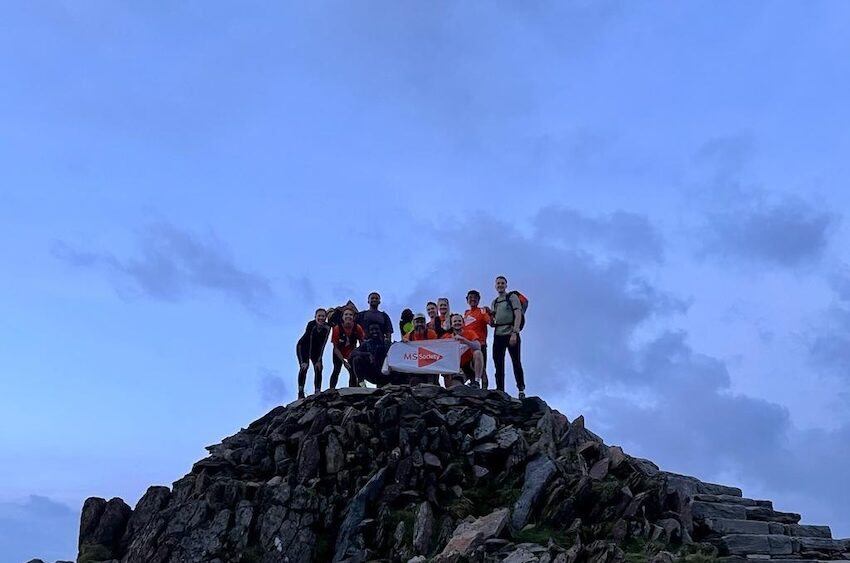
Jono and nine colleagues raced the Welsh 3000s in 2023, raising money for the MS Society.
Whether it’s an unglamorous training session through a London winter or a record-setting attempt in its Spring, Jono runs in pursuit of a different kind of healing. “It’s hard to put into words, but if I’m out running, and if I just keep going, it’s almost like my legs won’t ever stop, they’ll always work. The disease can’t catch up with me.”
Jono is determined to run far and fast with MS because he was determined to run far and fast before MS.
Pursuing a Guinness World Record is a way of acknowledging the disease while refusing to be defined by it. And it’s also a way to raise money to fund much-needed research and support to help, as Jono puts it, “the many people who aren’t as lucky as I’ve been.”
MS: A Quick Overview
“No two people with MS are the same,” Dr. Laura Hancock, a neuropsychologist specializing in MS, has said. “Once you’ve met one person with MS, that means you’ve met one person with MS.” MS doesn’t lend itself to generalization, yet it’s still often categorized as having three main types—relapse-remitting, primary-progressive, secondary-progressive—each of which tend to follow different rates of decline.
The MS Society lists 20 different primary symptoms associated with the disease—fatigue, walking difficulties, dizziness, and cognitive changes being among the most common—in addition to “secondary symptoms” caused by those primary ones. The severity of those symptoms can vary drastically. Most people are diagnosed with MS between the ages of 20 and 40. And according to figures based on U.S. data, three out of every four people diagnosed with MS are female. It is not an inherited disease—as in, it’s not passed down from generation to generation through genetics. And, curiously, rates of MS increase dramatically the further you get from the equator.
Treatments for MS have advanced rapidly in the last 20 years. “We now know enough about what goes wrong in MS, to know what needs to be done to develop treatments to stop it,” the MS Society UK writes. “Although there is no cure for MS, we can see a future where people can live free from its effects and not worry about their MS getting worse.”
